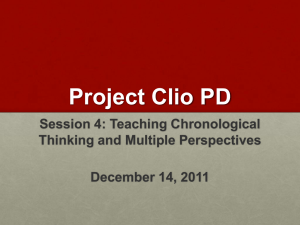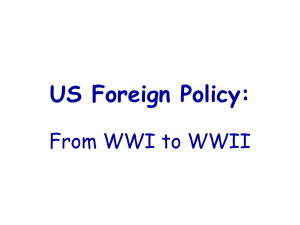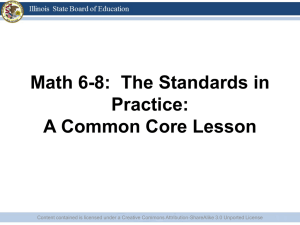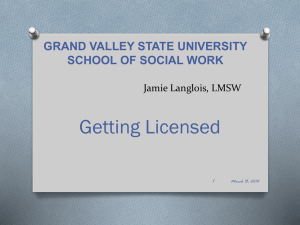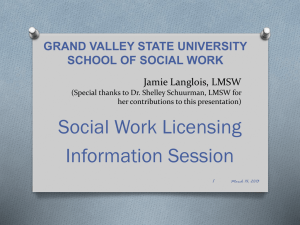Positive Language
advertisement
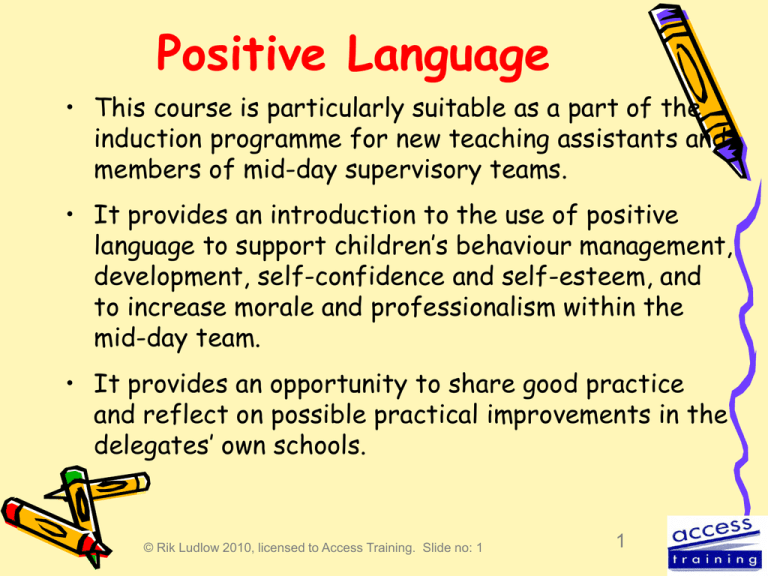
Positive Language • This course is particularly suitable as a part of the induction programme for new teaching assistants and members of mid-day supervisory teams. • It provides an introduction to the use of positive language to support children’s behaviour management, development, self-confidence and self-esteem, and to increase morale and professionalism within the mid-day team. • It provides an opportunity to share good practice and reflect on possible practical improvements in the delegates’ own schools. © Rik Ludlow 2010, licensed to Access Training. Slide no: 1 1 Positive Language Introductions.... Your trainer Do you know each other? © Rik Ludlow 2010, licensed to Access Training. Slide no: 2 Skills Active Overview: Access Training is accredited by SkillsActive and has signed up to its national Code of Practice SkillsActive “quality assure” the training. This training may be useful, or even count towards, other qualifications, such as NVQs. © Rik Ludlow 2010, licensed to Access Training. Slide no: 3 Positive Language: Objectives • To be aware of: – What positive language sounds like – The benefits of using positive language • To practice using positive language • To know how positive language can support behaviour management © Rik Ludlow 2010, licensed to Access Training. Slide no: 4 How does this course support The National Picture • The Five Outcomes: – – – – – be healthy stay safe enjoy and achieve make a positive contribution achieve economic well-being. • Safeguarding Children © Rik Ludlow 2010, licensed to Access Training. Slide no: 5 What are our values? • Warm up activity: – What do we want for our children? – What motivates us to do more, better, or to help others more? – What do we think of people who are • “positive”? • “negative”? © Rik Ludlow 2010, licensed to Access Training. Slide no: 6 Warm-up Feedback: • What do we want for our children? • What motivates us to do more, better, or to help others more? • What do we think of people who are a) “positive”? b) “negative”? © Rik Ludlow 2010, licensed to Access Training. Slide no: 7 Positive Language: What is it? • Optimist? Realist? • “Can do” approach • “Look on the bright side” • “Praise, not nag” • Notice the good, improve the bad • Give alternatives/choices – empower the child © Rik Ludlow 2010, licensed to Access Training. Slide no: 8 The Power of Positive Language • People do better when they feel better, not when they feel worse. © Rik Ludlow 2010, licensed to Access Training. Slide no: 9 The Power of Positive Language Flatter me and I may not believe you. Criticise me and I may not like you. Ignore me and I may not forgive you. Encourage me and I will never forget you. William Arthur Ward © Rik Ludlow 2010, licensed to Access Training. Slide no: 10 Being positive about ourselves We all have a responsibility to “do our bit” for society – Starting with ourselves! © Rik Ludlow 2010, licensed to Access Training. Slide no: 11 Positive Language: Our Responsibility Think of a successful relationship. Is it based on RULES (“follow rule ‘or else’, obedience, external control) Or Is it based on RESPONSIBILITIES? (expectation, aspiration, motivation, self- monitoring) © Rik Ludlow 2010, licensed to Access Training. Slide no: 12 Changing the language • Have positive expectations. Are these???? o “Don’t run along the corridor” o “Stop hitting Samantha” o “You are useless” Activity 2: What negative language have you heard? How could it be re-worded? © Rik Ludlow 2010, licensed to Access Training. Slide no: 13 Why is positive language good? Activity: With a partner, think what good effects might come from positive language. © Rik Ludlow 2010, licensed to Access Training. Slide no: 14 Why is positive language good? • Effects on health & immune system • Effects on morale, motivation • Effects on self-esteem • Effects on how we behave • Effects on developing trust and relationships • Effects on expectations and attitudes © Rik Ludlow 2010, licensed to Access Training. Slide no: 15 Compare: • If you think you can’t……. You probably can’t! • If you think you can…… You probably will be able to do it! © Rik Ludlow 2010, licensed to Access Training. Slide no: 16 Positive Language for key behaviours • • • • • Talk about the behaviour, not the person. Say what you WANT to happen. Explain what, how, when. Don’t dwell on the “otherwise” consequences Praise what DOES happen as wanted Planned ignoring of what does not go right (and later follow-up possibly) “Positive behaviour management” tactic Activity: Choose from (a) or (b) (a) We do NOT say what we do NOT WANT to happen. Why not? (b) We ONLY say what we DO WANT to happen. Why? © Rik Ludlow 2010, licensed to Access Training. Slide no: 17 Behaviours have consequences Consequences can be POSITIVE or NEGATIVE • An IMPOSED consequence is negative unless the person likes it! • An IMPOSED consequence sounds like a threat. • You as adult are then responsible for checking! • What does this say about our trust in the child? Try instead: Internal motivation • Yes, you can do X just as soon as you have done Y • Yes, if you have done Y then you can do X The child is then responsible for self- monitoring What does this say about our trust in the child? © Rik Ludlow 2010, licensed to Access Training. Slide no: 18 Behaviours have consequences Which may work better? “You must stay at the table until you have finished your dinner” “Eat your dinner or else” “You can go and play as soon as you have finished your dinner” © Rik Ludlow 2010, licensed to Access Training. Slide no: 19 Making choices are behaviours. Behaviours have consequences • Many children cope better with a limited choice • Some children need to be reminded what their choices are. • They need to be allowed to make their own choice, and thus decide their consequence. © Rik Ludlow 2010, licensed to Access Training. Slide no: 20 Positive Language for difficult times • The image people have of themselves often drives their behaviours. • Some people have to believe in someone else’s belief in them until they start to believe it themselves. • YOU are that “someone else”. Which challenging child do you believe in? © Rik Ludlow 2010, licensed to Access Training. Slide no: 21 Teaching Positive Language: • Children need positive role models • Simple instruction: Teach what you want. Teach the vocabulary • Teach by example – Respect, responsibility: Model and ask child to copy. • Reinforcement – Instant and delayed rewards • Praise, encourage and have high expectations. • Indirect praise as a strategy © Rik Ludlow 2010, licensed to Access Training. Slide no: 22 Teaching Positive Language: Activity: What rewards do you have? What rewards may you develop? © Rik Ludlow 2010, licensed to Access Training. Slide no: 23 The most positive thing to be is…….. Consistently positive No “off days”. Every day is an ON day. – (think – change of face, escape strategies). • Always expect a child will reach perfection………. One day! Our job is to help them move towards it. • A smile changes behaviours faster than a scowl, and feels better! • Do YOU trust people more if they are consistent? © Rik Ludlow 2010, licensed to Access Training. Slide no: 24 A Positive Approach, Rewards and sanctions • • • • • • Remember 20:1 ratio! Draw attention to what you WANT Model what you WANT Praise what you WANT Rewards usually work better than sanctions CONSISTENCY is essential • Work on behaviour management skills and strategies within the team © Rik Ludlow 2010, licensed to Access Training. Slide no: 25 Responsible thinking skills Activity: How might you help to develop children’s “responsible thinking skills”? © Rik Ludlow 2010, licensed to Access Training. Slide no: 26 Problem Case Studies Behaviours you have experienced: – – – – – Challenging Withdrawn Inappropriate Bullying Other © Rik Ludlow 2010, licensed to Access Training. Slide no: 27 Positive Language: What next? Final activity: Key points What are we doing well? What might we change? © Rik Ludlow 2010, licensed to Access Training. Slide no: 28 How can we now better support The National Picture • The Five Outcomes: – – – – – be healthy stay safe enjoy and achieve make a positive contribution achieve economic well-being. • Safeguarding Children © Rik Ludlow 2010, licensed to Access Training. Slide no: 29 Headings for Action Plan • Name of school Date • Priorities for change • What might you want to experiment with in order to improve effectiveness? • Agreement about any common approaches you are ready to adopt • Agreements re: – commitments to any further explorations/piloting of change – identify any support you need • How will you track your progress and share experience? • Date of review © Rik Ludlow 2010, licensed to Access Training. Slide no: 30 Questions & Further Help • Access Training: www.trainyourschool.co.uk – 229 Scraptoft Lane, Leicester LE5 2HT – 0116 241 5801 • Tear-off slip at bottom of evaluation form • Resources: Handouts- & ideas for further reading © Rik Ludlow 2010, licensed to Access Training. Slide no: 31 Conclusion • ACTION to improve management of behaviours through positive language • Evaluation Sheets • Certificates • Notes, Bibliography, Web Site • Action Plans © Rik Ludlow 2010, licensed to Access Training. Slide no: 32 Positive Language: Objectives • To be aware of: – What positive language sounds like – The benefits of using positive language • To practice using positive language • To know how positive language can support behaviour management © Rik Ludlow 2010, licensed to Access Training. Slide no: 33 © Rik Ludlow 2010, licensed to Access Training. Slide no: 34
